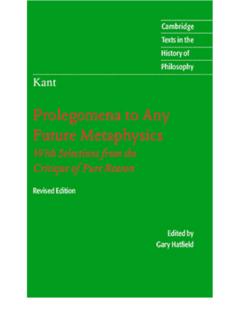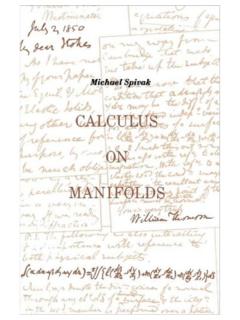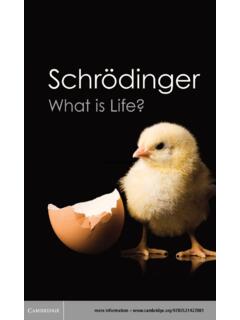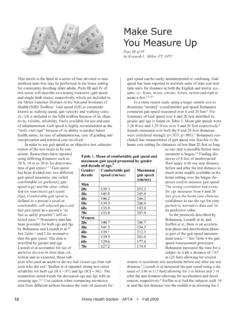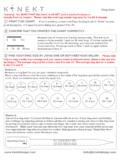Transcription of Measure Theory 1 Measurable Spaces - Strange …
1 MeasureTheory1 MeasurableSpacesAmeasurablespaceis a setS, togetherwitha nonempty collection,S, ofsubsetsofS, satisfyingthefollowingtwo conditions:1. For anyA; Bin thecollectionS, theset1A Bis For anyA1; A2; 2S,[ conditionsaresummarizedby sayingthatthemeasurablesetsareclosedunde rtaking nitedi thearenain which alltheaction(integrals,etc)willtakeplace ;andof themeasurablesetsarethosethatare\candida tesforhavinga size".In someexamples,allthemeasurablesetswillbe assigneda \size";in others,onlythesmallermeasurablesetswillb e (withtheremainingmea-surablesetshaving,e ectively\in nitesize").Severalpropertiesof measurablesetsareimmediatefromthede set,;, is Measurable .]
2 [SinceSis nonempty, thereexistssomemeasurablesetA. So,A A=;is Measurable ,by condition1 above.] two measurablesets,A\B,A[B, andA Bareallmeasurable.[Thethirdis justcondition1 thesecond,applycondition2 tothesequenceA; B;;;;; . Forthe rst,notethatA\B=A (A B): Usecondition1 twice.]It followsimmediately, byrepeatedapplicationof thesefacts,thatthemeasurablesetsareclose dundertakingany nitenumbersof intersections,unions,anddi ForA1; A2; Measurable ,theirintersection,\Ai, is alsomeasurable.[Firstnotethatwe have thefollowingset-theoreticidentity:A1\A2\ A3\ =A1 f(A1 A2)[(A1 A3)[(A1 A4)[ g. Now,ontheright,applycondition1 above to theset-di erences,andcondition2 to theunion.]]]]]
3 ]Thus, LetSbe any set,andletSconsistonlyof theempty set;. Thisis a(ratherboring) B, we meanA\Bc, ,thesetof allpoints any set,andletSconsistof allsubsetsofS. Thisis LetSbe any set,andletSconsistof all subsetsofSthatarecountable(or nite).Thisis a any set,and xany nonempty collectionPof subsetsofS. LetSbe thecollectionof Now expandSto includeallsetsthatresultby takingdi erencesandcountableunionsof setsinS. Next,againexpandSto includeallsetsthatresultby takingdi erencesandcountableunionsof setsin (thealreadyexpanded)S. Continue in thisway2, (S;S) is a ,youcangeneratemeasurablespacesby startingwithany setS, andanycollectionPof subsetsofS( ,thosethatyoureallywant to turnout,in theend,to be Measurable ).
4 ByexpandingthatoriginalcollectionP, as describedabove, youcanindeedachieve a measurablespacein which (S;S) be any measurablespace,andletK S(notnecessar-ilymeasurable).LetKdenotet hecollectionof (K;K) is a measurablespace.[Thetwo propertiesfor(K;K) follow immediatelyfromthecorrespondingpropertie sof (S;S).]Thus,each subsetof a measurablespacegives riseto a newmeasurablespace(calledasubspaceof theoriginalmeasurablespace).6. Let(S0;S0) and(S00;S00) be measurablespaces,basedondisjoint [S00, andletSconsistof allsetsA Ssuch thatA\S02 S0andA\S002 S00. Then(S;S) is a measurablespace.[Thetwo propertiesfor(S;S) follow immediatelyfromthecorrespondingprop-erti esof (S0;S0) and(S00;S00).]]
5 For instance,the rstproperty followsfrom:(A B)\S0= (A\S0) (B\S0) and(A B)\S00= (A\S00) (B\S00).]2 MeasuresLet(S;S) be a (S;S) consistsofanonempty subset,M, ofS, togetherwitha mappingM !R+(whereR+2 Inmoredetail:SetS1=P. LetS2thesetthatresultsfromapplyingtheabo veprocesstoS1; thenbyS3thesetthatresultsfromapplyingthe processtoS2, [S2[ .2denotesthesetof nonnegative reals),satisfyingthefollowingtwo conditions:1. For anyA2 MandanyB A, withB2S, we LetA1; A2; 2 Mbe disjoint, andsetA=A1[A2[ . Then:ThisunionAis inMif andonlyif thesum (A1) + (A2) + converges;andwhentheseholdthatsumis precisely (A).A setA2 Mis saidtohave Measure ; and (A) is calledthemeasureofA.]]]
6 Thinkof thecollectionMas consistingof thosemeasurablesetsthatactuallyareassign eda \size"( ,of thosesize-candidates(inS) thatweresuccessful);andof (A) as rstconditionabove says thatallsu measurablesetAhasfornotbeingassigneda sizeis that\thereis alreadytoo much measureinsideA", ,thatAe ectivelyhas\in nitemeasure".Thelastpartof condition2 saysthatmeasureis additive undertakingunionsof disjoint sets(somethingwewouldhave wantedandexpectedto be true).Severalpropertiesof measuresareimmediatefromthede Theempty set;is inM, and (;) = 0. [ ;andapplycondition1, to conclude;2M. Now applycondition2 to thesequence;;;; (havingunionA=;).]
7 SinceA2 M, we have (;) + (;) + = (;), which implies (;) = 0.]2. For anyA; B2M,A\B,A[B, andA Bareall inM. Furthermore,ifAandBaredisjoint, then (A[B) = (A) + (B). [The rstandthirdfollow immediatelyfromcondition1, sinceA\BandA BarebothsubsetsofA. For thesecond,applycondition2 to thesequenceA B; B;;;;; ofdisjoint sets,withunionA[B. Additivity of themeasuresalsofollowsfromthis,sincewhen AandBaredisjoint,A B=A.] anyA; B2 M, withB A, then (B) (A). [We have, bythepreviousitem, (A) = (B) + (A B).]Thus,\thebiggertheset,thelargeritsme asure".4. For anyA1; A2; 2M,\Ai2M. [Thisis immediatefromcondition1 above, since\Ai2 Sand\Ai A12M.]]]
8 ]Thus,thesetsthathave Measure ( ,thosethatareinM) areclosedunder nitedi erences,intersectionsandunions;as wellas ; A2; be a sequenceof setsinM,notnecessarilydisjoint. Firstnotethat[Ai=Acanalways bewrittenas a unionof a collectionofdisjointsetsinM, namelyofA1; A2 A1; A3 A2 A1; . If thesumof themeasuresof thesetsin thislastlist3converges,then,by condition2 above, we areguaranteedthatA2M. Andifthesumdoesn'tconverge,thenwe areguaranteedthatAis notinM. Note,incidentally, thatconvergenceof thissumis guaranteedby convergenceofthesum (A1) + (A2) + (A3) + (but,withoutdisjointness,thislastsummay exceed (A)).In short,thesetsthathave measurearenotin generalclosedundercountableunions,butfai lureoccursonlybecauseof LetSbe any set,letS, thecollectionof measurablesets,be allsubsetsofS, letM=S, and,forA2M, let (A) = 0.
9 Thisis a (boring) any set,Sallcountable(or nite)subsetsofS,Mthecollectionof all nitesubsetsofS, and,forA2M, let (A) be thenumberof elements in thesetA. Thisis is calledcountingmeasureonS. NotethatthesetSitselfcouldbe any setandSthecollectionof allsubsetsofS. Fixanonnegative functionSf!R+onS. Now letMconsistof allsetsA2 Ssuch that ,Mincludesallthe nitesubsetsofS; andpossiblysomecountablyin nitesubsets(providedthereisn'ttoo muchfonthesubset);andpossiblyevensomeunc ountablein nitesubsets(providedfvanishesa lotonthesubset).ForA2 M, set (A) = Af. Thisis 1, it reducesto (S;S;M; ) be any (notnecessarilyinS).
10 DenotebyKthecollectionof allsetsinSthataresubsetsofK; andbyMKthecollectionof allsetsinMthataresubsetsofK. ForA2MK, set K(A) = (A). Then(K;K;MK; K) is againa mea-surablespace/ Measure .[Thisis aneasycheck, usingforeach property, thecorrespondingproperty of (S;S;M; ).]Thus,any subsetof theunderlyingsetSof a spacewithmeasuregives riseto called,of course, Let(S0;S0;M0; 0) and(S00;S00;M00; 00) be measurablespaces/measures,withS0andS00di sjoint. SetS=S0[S00; letSconsistofA Ssuch thatA\S02 S0andA\S002 S00. LetS(resp,M) consistofA Ssuch thatA\S02 S0andA\S002 S0(resp,2 M0and2 M00). Finally, forA2 M,set (A) = 0(A\S0) + 00(A\S00).]

